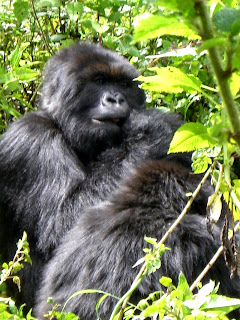 Nyungwe Forest is the largest surviving patch of montane forest in Africa, home to 14 species of primate and 283 species of birds. I took three guided walks (the only way to visit) and saw several of each. It did feel a little surreal creeping through primary rainforest, dripping with mosses and giant tree ferns, in search of the Ruwenzori turaco (like some kind of intrepid naturalist), but the forest was beautiful, and we did indeed see the turaco plus several other beautiful and/or rare species of bird.
Nyungwe Forest is the largest surviving patch of montane forest in Africa, home to 14 species of primate and 283 species of birds. I took three guided walks (the only way to visit) and saw several of each. It did feel a little surreal creeping through primary rainforest, dripping with mosses and giant tree ferns, in search of the Ruwenzori turaco (like some kind of intrepid naturalist), but the forest was beautiful, and we did indeed see the turaco plus several other beautiful and/or rare species of bird.I suppose to a real twitcher the Grauer's rush warbler was the most thrilling sighting, found only in that region and amongst the rarest birds in Africa, but in fact it was a rather boring little brown thing, and I was much more excited by the commoner but beautiful bar-tailed trogon, with its blue chest, red belly, green back and wings and long black and white barred tail.

Also beautiful (I'm using that word too much, but it does apply rather a lot in Rwanda) was a troop of Angolan colobus monkeys - and I also saw blue monkeys and mountain monkeys during my searches for birds. I decided not to spend $50 on a chimp-tracking walk, as this could be up to eight hours of difficult walking/climbing/scrambling up and down steep and slippery mountainsides as the troop moves around so much. After all, I had the gorillas to look forward to in the Volcanoes National Park!
This park is a chain of five or six volcanoes, on the border with DR Congo and Uganda. Some 320 of the world's remaining 700 mountain gorillas live on the Rwandan side, and for $500 you can climb up with a guide and a couple of armed guards (protecting against poachers who kill the females and steal their babies for private zoos) to track one of the family groups and spend an hour with them.
I chose to track the Susa group - the biggest with 39 members but also usually the hardest to reach. Being low season, I did not have to fight for the privilege of tracking this group, which is often the most sought after, in fact there were only three of us doing the trek which was good news.
After an hour's drive we started our walk, which began with an hour or so up a steep-sided hill through farmers' fields. We were already at 2,600m (more than 3,000m by the time we reached the forest), and soon my heart was thudding and my leg muscles were screaming for oxygen. Thankfully there was no pressure to go quickly. When we got to the bamboo forest the slope lessened, but then we were faced with a new obstacle - stinging nettles! Vicious stinging nettles, powerful enough to sting through trekking trousers, and so many of them that they could not be avoided. However, we soon forgot about our stings as we heard crashing sounds nearby - the gorillas!!
My heart was thudding again, but this time with excitement. A lifelong ambition about to be realised. It's hard to convey the feelings I had when we actually saw the gorillas. They are ENORMOUS, and powerful, yet so gentle (and covered with the longest, softest-looking fur) and clearly no danger to us whatsoever.

Our briefing had told us that we had to maintain a seven metre distance between us and them, but this rule does not seem to be strictly observed, at least not by the gorillas. The youngsters played around us, climbing trees and crashing down amongst the group, whilst the indulgent parents looked on, not interrupting their long meal (they eat some 30kg of vegetation each day) or their grooming. It looked like an easy, lazy existence, though I was surprised to see a couple of the young males beating their chests, King Kong style - yes, they really do that!
 There were four enormous silverbacks, a number of younger males, many females and quite a few youngsters. The guide later told us that we had seen 37 of the 39 gorillas in the Susa group - 5% of the total population of this endangered species!
There were four enormous silverbacks, a number of younger males, many females and quite a few youngsters. The guide later told us that we had seen 37 of the 39 gorillas in the Susa group - 5% of the total population of this endangered species!Our hour in their presence passed far too quickly.





